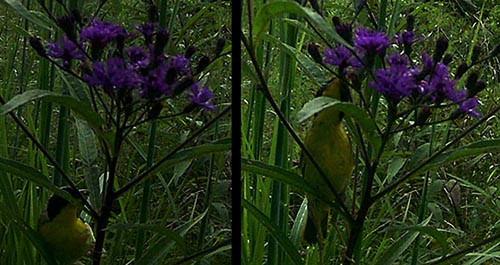
In previous articles, I’ve talked about various ways to attract pollinators and wildlife. However, part of the fun of attracting them is getting to watch them, and not all of our pollinators and wildlife will tolerate having a human observer nearby. So this week I’ve invited Charlie Logsdon, a biologist at Roundstone Native Seed, to share with us a technique they have been using to observe pollinators and other wildlife in their wildflower plantings.
~ Shannon
Trail cameras for Pollinators
By: Charlie Logsdon, Roundstone Native Seed
The plight of the honeybee and the monarch have brought the role of pollinators to the attention of the public. However, a vast diversity of other pollinators also exist. One fun way of observing this diversity is to use trail cameras to document the occurrence of pollinators on flowering plants. While this technique will primarily focus on large, identifiable species (butterfly, moths, some large bee species), numerous small species can be observed.
Items needed:
• Trail camera and strap to secure it.
• SD card
• T-post
• Butterfly and insect field guides to help with identifying what you see in the pictures
• Card viewer or computer

Camera setup:
Each brand of camera varies in setting options. The length of time between each triggering, the number of photos taken at each triggering, and the sensitivity of the camera are the primary options to focus on. Also, most cameras can be set to display the time and date when the pictures were taken. Here at Roundstone, we use the following settings:
- A burst of 3 photos taken each time the camera is triggered. There are several advantages to this option. First, it allows movement of small pollinators to be detected due to changes in position between shots. What may appear to be a dot on the photo may actually be a small bee, fly, or moth.
- Time between triggering can be set from seconds to up to hours. I recommend setting the camera to trigger with either 5 or 15 minutes between shots. If you plan to check the camera after 1 hour, set the camera for 5 minutes between shots. For longer sampling periods, use 15 minutes. This variation keeps the number of photos to a reasonable number. In a heavily visited area the camera can be triggered every 5 minutes. If this continues for several hours the number of photos can easily be in the hundreds.
- Since many of the pollinators are extremely small, the sensitivity of the camera is set to high. This allows it to be triggered with the smallest amount of movement.
Camera position:
The camera should be positioned 18-24” from the flower. This is done by driving a fence post into the ground beside the plant. The orientation (above, below, or even) in relation to the plant can be experimented with to determine what will give the best photograph. Ideally the camera should be facing a northerly direction. This will eliminate the possibility of the sun backlighting the plant making it impossible to identify pollinators. If multiple cameras are used on the same plant (to get photos of pollinators at different angles for identification) make sure the cameras are out of the field of view of the other cameras.

Data recording:
While just identifying species is fun, you might want to develop a data sheet to record other interesting data. Possible data you might want to record, includes:
- Species present and the numbers of each species.
- Interaction of species if more than one species is present on the flower at the same time.
- Time of day when each pollinator appears.
- Stage of blooming when various pollinators use the plant.
- General comments: For example, in one of the pictures, a bird (Common Yellowthroat) can be seen under the flower apparently hunting for insects.

Roundstone Native Seed has been growing and supplying high quality regionally adapted Native Seeds to the Eastern half of the US for over 20 years. We are farmers and conservationists and have grown from a small family-owned business to one of the largest seed providers in the East. Our success can be attributed to our commitment to clean high quality seed, development of Ecotypes adapted to each region we serve, and an experienced and knowledgeable staff dedicated to friendly helpful service. We focus on quality and service because every success we bring our Customers is a living demonstration and an incentive for others to use natives.

This article was part of Shannon’s original Kentucky Pollinators and Backyard Wildlife blog which evolved into the blog for Backyard Ecology.

Backyard Ecology: Exploring Nature in Your Backyard
Nature isn’t just “out there.” It’s all around us, including right outside our doors. Hi, my name is Shannon Trimboli, and I am the host of Backyard Ecology. I live in southcentral Kentucky and am a wildlife biologist, educator, author, beekeeper, and owner of a nursery specializing in plants for pollinators and wildlife conservation. I invite you to join me as we ignite our curiosity and natural wonder, explore our yards and communities, and improve our local pollinator and wildlife habitat. Learn more or subscribe to my email list at www.backyardecology.net.

Leave a Reply